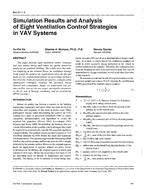Description
Presents eight ventilation control strategies and their annual energy and indoor air quality simulation results for an academic building. States the results show that without tempering at the terminal boxes, no ventilation strategy could satisfy the outdoor air requirements when the thermal loads are low, and the fixed outdoor air percentage method is the worst one. States that from an economic perspective, strategies using optimisation techniques minimise the operation energy demand and consumption. Concludes that supply air temperature and primary airflow rate are the two proper optimisable parameters on the air side of HVAC systems.
Units: Dual
KEYWORDS: year 1997, Ventilation, controls, buildings, calculating, comparing, energy consumption, indoor, air quality, air conditioning, variable volume air conditioning
Citation: Symposium, ASHRAE Transactions, Vol.103, Part 2, Boston 1997
Product Details
- Published:
- 1997
- Number of Pages:
- 12
- File Size:
- 1 file , 1.4 MB
- Product Code(s):
- D-16486




